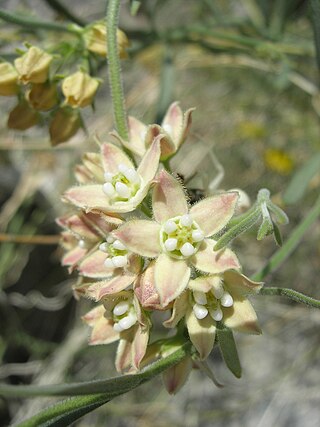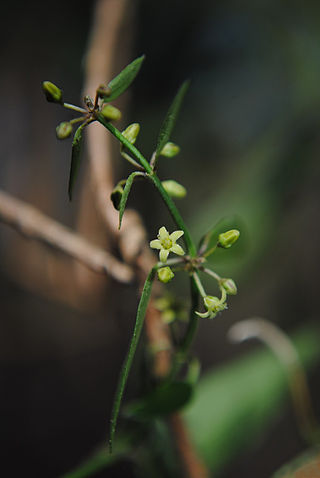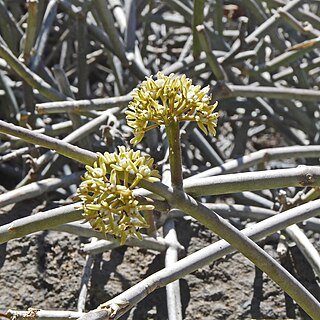
The Asclepiadoideae are a subfamily of plants in the family Apocynaceae. Formerly, they were treated as a separate family under the name Asclepiadaceae, e.g. by APG II, and known as the milkweed family.

Cynanchum is a genus of about 300 species including some swallowworts, belonging to the family Apocynaceae. The taxon name comes from Greek kynos and anchein, hence the common name for several species is dog-strangling vine. Most species are non-succulent climbers or twiners. There is some evidence of toxicity.

Vincetoxicum rossicum is a flowering plant in the family Apocynaceae. It is a perennial herb native to southern Europe and is a highly invasive plant growing in all of the Eastern United States, in the mid west, and southern Ontario and Quebec in Canada. It has several common names including swallowwort, pale swallowwort, and dog-strangling vine. There has historically been much confusion about the genus it belongs to, with authors placing it within Vincetoxicum and others within Cynanchum, but recent molecular and chemical analyses have shown it to belong in the genus Vincetoxicum.

Sarcostemma is a formerly recognized genus of flowering plants in the dogbane family, Apocynaceae, first described as a genus in 1810. The name is derived from the Greek words σαρκὸς (sarkos), meaning "flesh," and στέμμα (stemma), meaning "garland". Members of the genus were known generally as climbing milkweeds or caustic bushes. The genus Sarcostemma has been shown to be nested within the genus Cynanchum, and in 2012 Sarcostemma was put into synonymy with Cynanchum.

Cynanchum socotranum, synonym Sarcostemma socotranum, is a species of plant in the family Apocynaceae. It is endemic to Socotra Island, south of Yemen. Its natural habitat is subtropical or tropical dry shrubland.

Vincetoxicum is a genus of plants in the family Apocynaceae. Although the species in Vincetoxicum have sometimes been included in Cynanchum, chemical and molecular evidence shows that Vincetoxicum is more closely related to Tylophora, now included in Vincetoxicum. The generic name means "poison-beater" in Botanical Latin because of the plants' supposed antidotal effects against snakebite.

Funastrum hirtellum, synonym Sarcostemma hirtellum,, is a perennial, vine-like plant of mid- to lower-elevation desert regions. It is a member of the family Asclepiadaceae and the genus Funastrum. It is found in the southwestern United States and northwestern Mexico — in southeastern California, southern Nevada, Arizona, Sonora, and Baja California.

Cynanchum viminale is a leafless succulent plant in the family Apocynaceae. The species is native to West Africa, the Indian Ocean and Western Pacific region. The species' natural range extends from South Africa throughout much of Africa and the Middle East to India, Indochina, Southern China, Indomalaya and into Meganesia. The species is also found on several Indian Oceans islands including Mauritius, Réunion and the Seychelles.

Funastrum is a genus of flowering plant now in the family Apocynaceae. The name is derived from the Latin word funis, meaning "rope", and astrum, alluding to the twining stems. Members of the genus are commonly known as twinevines.
Metastelma arizonicum, synonym Cynanchum arizonicum, the Arizona swallow-wort or Arizona climbing milkweed, is a plant native to Arizona, New Mexico and Sonora. It is a twining, herbaceous vine with whitish to yellow flowers, growing on rocky slopes and in canyons of desert mountain ranges.

Funastrum cynanchoides, also known as fringed twinevine, twining milkweed or climbing milkweed, is a perennial plant in the family Apocynaceae that grows twining through other plants in the Mojave Desert and Sonoran Desert. It has milky sap and smells pungent. It is similar to Funastrum hirtellum.

Orthosia is a genus of plants in the family Apocynaceae, first described as a genus in 1844.
Jobinia is a genus of flowering plants of the family Apocynaceae first described in 1885. It is native to South America and Central America.

Cynanchum daltonii, synonym Sarcostemma daltonii, is a species of flowering plants of the family Apocynaceae. The species is endemic to Cape Verde. The specific name refers to Joseph Dalton Hooker. The species was named by Joseph Decaisne, as Sarcostemma daltonii, in 1849. Its local name is gestiba. The plant is used in traditional medicine to relieve and treat dental problems.
Marsdenia mackeeorum is a species of vine in the family Apocynaceae. It is endemic to New Caledonia.
Funastrum angustifolium is a plant species. Commonly known as the Gulf coast swallow-wort, it is a perennial dicot that grows in the southern United States as far west as Texas. It is in the Cynanchum genus and Apocynaceae family. A flowering vine, it produces white blossoms with greenish and yellow parts. A member of the milkweed family, it is a plant host for monarch butterflies and produces wind dispersed seed pods.

Vincetoxicum bracteatum, synonyms including Tylophora pauciflora, is a species of climbing plant in the family Apocynaceae. It is commonly known as kiri aguna in Sri Lanka. It is edible and is used in traditional medicine. It was first described by Carl Peter Thunberg in 1821 as Cynanchum bracteatum.
Vincetoxicum rupicola is a species of plant in the dogbane family Apocynaceae that is endemic to Queensland, Australia. It was first described by Paul Forster in 1992 as Tylophora rupicola.
Vincetoxicum forsteri is a species of plant in the dogbane family Apocynaceaethat is endemic to Australia. It was first described by Paul Forster in 1992 as Tylophora linearis.
Cynanchum violator is a species of flowering plant in the family Apocynaceae, native to wet tropical areas of Táchira state, Venezuela. A scrambling subshrub, it is so named because it possesses a number of character traits often used to delimitate sections and even genera in related taxa.













